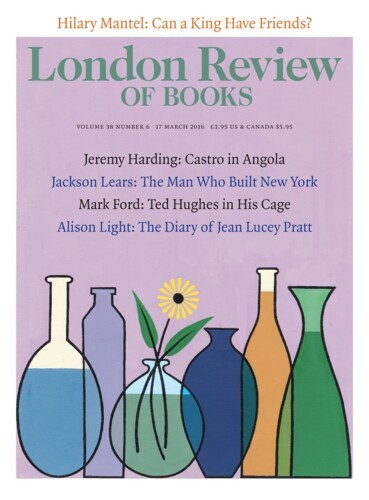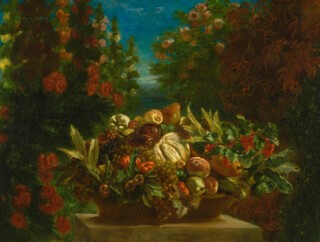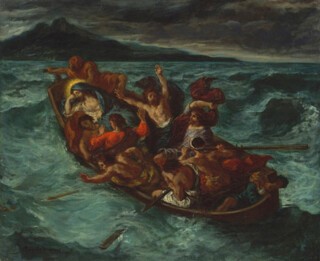A canvas begun in the autumn of 1848 and finished the following spring is, at four foot eight inches wide, one of the heftier items in Delacroix and the Rise of Modern Art, an exhibition at the National Gallery (until 22 May) in which paintings by Eugène Delacroix mingle with others by artists he influenced. In factual terms, Delacroix presents us with a September evening in a country garden, in which the last light lingers on a basket piled deep with produce and on the roses and hollyhocks overhead. The produce, in all its lush diversity (gourds, peaches and medlars, redcurrants and grapes), looks to have been bought from a stall in Les Halles, 12 miles from Delacroix’s out-of-Paris getaway, but without any thought of the dinner table. In truth, questions of location and function count for very little in A Basket of Fruit in a Flower Garden. What does seem to matter, though, is time, or forms of resistance to it – the lingering, the lateness, the harvesting. Much moved by this stately visual feast, I struggle to name what feelings it induced. ‘Nostalgia’ comes quite near.
Facts mattered less to Delacroix than the principle that a painting should form a ‘bridge’ from mind to mind. ‘I have told myself a hundred times that painting – that is, the material thing called a painting – is no more than a pretext,’ he wrote in his journal on 18 July 1850, ‘the bridge between the mind of the painter and the mind of the spectator.’ What emotions, then, ran up to the bridge from his side? Why did he make this big thing? By way of a refusal to make yet bigger things, according to his recent biographer Marie-Christine Natta: she calls Delacroix’s still lifes of 1848 the ‘secret protest’ of a politically phlegmatic 50-year-old declining to match Liberty Leading the People of 1830 with an Equality on the Barricades fitted to that year’s revolution, as the critic Théophile Thoré had demanded. (Liberty and other furious youthful bids for Salon glory are absent from this exhibition, in which the paintings are predominantly intimate in scale.)
Instead, Delacroix assembled, with middle-aged deliberation (the National Gallery’s press release, calling him ‘the very model of a bohemian’, speaks of a youthful persona little seen on these walls), a compendium of specimens of nature that is equally a compendium of pigments and mediums. The switch from tomato to aubergine becomes a switch from the fattest vermilion to the gauziest suspension of violet-tinged varnish. These colour forays bounce off against one of easel painting’s structural problems, as French tradition defined it – how to unify, how to arrive at cohesive effect through rhythms of highlights and darks. The canvas should be analogous to greater ensembles: as Roger de Piles wrote, establishing the principle in 1708, ‘All the world’s entities tend to unity … just as politics refers everything to the government of a state.’ A centred composition might thus have statist resonances, serving as a rebuke to ephemeral calls to action; as so often with still life, things in arrangement flip over into thoughts in contemplation.
But on this side of the bridge, such stoic wisdom could equally be read as autumnal wistfulness. It is not that plants and botany specifically interested Delacroix, in the way they interested Jan de Heem and Jean-Baptiste Monnoyer, who had painted the last flowerpieces of this size back in the 17th century: it is rather that the idea of being interested in such things interested him. ‘Subject matter had always been central to Delacroix’s art,’ the curator Christopher Riopelle writes in the exhibition catalogue. Yes – in that a yearning for subject matter becomes in effect Delacroix’s very own subject. The brooding that his Basket of Fruit in a Flower Garden conveys is the feeling with which you might try out someone else’s old love song, wishing to be likewise in love.
Delacroix tried out a great many old songs. Two centuries previously, Rubens had created a vision of the crucified Christ. What Delacroix re-created in its wake, with his own Christ on the Cross, was a vision of a Rubensian ethos in painting, one in which physical sufferings are instantly redeemed by their own rhythmic visual attractiveness. The holy persons worshipped in another nominally religious canvas, a Lamentation which like the Basket of Fruit was meant for the open market, were not Jesus and Mary but Titian and Poussin. Whereas in his writings Delacroix frowned on the mannerisms of Boucher, he could launch into wholesale Rococo fantasia in a canvas of Bathers in a woodland stream. Curiosity, perhaps, on the part of the Louvre’s most devoted student, who considered that ‘the force, the fecundity, and the universality’ of the great Renaissance artists put to shame ‘our miserable little pictures painted for our miserable dwellings’. To be born in 1798 was to arrive very late: they ‘have left but little for us to do’.
In light of this, to entitle a show Delacroix and the Rise of Modern Art is to set yourself an uphill struggle. Its protagonist was so very chary about the present and the future. (‘The absence of the nude and the poverty of costumes’ inclined him to avoid ‘modern subjects’.) Twenty-first-century London has a language to learn, in order to settle in with this imperious, consummately sophisticated yet solitary man, who lived without partner and almost without pupil and whose working days were largely spent decorating palaces and churches under Louis-Philippe and Napoleon III. The exhibition offers a quick video tour of these Paris murals, but this is inevitably frustrating and I wish we had instead been shown some working drawings.
These would have emphasised how much arduously elaborated thought, close reading and research underpinned Delacroix’s compositions. This is not always obvious because afterwards Delacroix would subordinate outlines to excited storms of top-layer brushwork. A Goethe drama about a Renaissance robber baron had long since been absorbed into his repertory before he painted the little canvas Weislingen Captured by Goetz’s Men in 1853, as no doubt had the wardrobe resources of the Comédie-Française. To work out whose limb is whose in the scene’s writhing knot of horses and riders might take some time, but the concerted visual impact of the fancy clothes, yellow, rose madder and Prussian blue, is instantaneous. With Delacroix, factual legibility yields to pictorial unity, and contour to colour. But as I see it, there was an interdependence any actor would recognise. To whip up a passion, he needed first to learn his lines.
Sheer visual impact was not, after all, the sum of his objectives. If, as he hoped, Delacroix still speaks mind to mind, it is partly because his handiwork draws us into a web of excited nervousness. The painter loftily ruminating on culture in his journal became jittery about his high ambitions as soon as he entered the studio. And this hesitancy – his failure, if you like, to be Rubens, his tendency to deviate from clearly delivered content – offers one viable basis for tracing Delacroix’s modern legacy. His wilfully confected Bathers take on new urgency when you hang next to them Cézanne’s yet more dream-convulsed Battle of Love, one defiant internal dialogue reinvigorating another. Matisse, you might argue, is a further case of heroic anxiety. But exhibiting his hot urgent scrabbles, the Japonaise of 1905 and the Red Carpet of 1906, ties up an alternative account of how painters interpreted Delacroix in the four decades after his death. The consensus became that deep, instantaneous communication through force of colour was the directive for modern art proposed by the master, but that they might regard other aspects of him – the love of literary references or the hard-pushed draughtsmanship – as optional. There are reasons here to exhibit Renoir canvases on the one hand, Redon pastels on the other.
Gauguin and Van Gogh have roles to play too, but Riopelle and his fellow curator Patrick Noon also chase some distractingly tenuous connections. Courbet, Monet and Signac don’t sit well with an artistic forebear who kept issues of observable fact so low on his agenda. Why exhibit the banal Frédéric Bazille rather than Adolphe Monticelli, who forms the missing link between Eugène and Vincent? Fantin-Latour may have been as studiously thoughtful as Delacroix, but by the same token he needs more space to explain himself than he’s granted here – and press-ganging one of his allegories into concluding the display is like thrusting an understudy on stage to deliver the encore.
But Riopelle and Noon do well to emblazon on the walls Delacroix’s answer to his own great conundrum. ‘Oh! Young artist, you want a subject? Everything is a subject; the subject is yourself.’ A thought he symbolised in Christ on the Sea of Galilee, the exhibition’s most visionary image: the saviour-artist asleep in the storm-tossed boat amid its desperate rowers, dreaming up both them and the storm, himself their salvation. ‘You must look within yourself and not around yourself,’ as his sermon to artists concludes. The tension driving this obsessional picture-poem is the anxiety plaguing a solipsist: if all must be ‘me’, how shall ‘me’ be defined? Must some wild sea yet lie beyond?
What is not ‘me’ can’t be known, Delacroix declared in his journal on 30 April 1850, baffled after watching trails and counter-trails of ants moving along a woodland path: all beings in the universe are forever ‘indecipherable for one another’. And yet there might be zones of half-knowledge, bridges for negotiation. Typically Delacroix assigned them to North Africa. Morocco and Algeria became part of a personal imaginary after his 1832 visit, which followed the French invasion of Algeria. On the modest scale of this show, the operation comes across less as political than as contemplative and abstract. Ecstatic Sufis and frenetic horsemen stand as junctures where the wild becomes the cultural, giving civilisation its necessary wellsprings of energy. The ‘living antiquity’, as Delacroix put it, of their grand gestures and noble robes becomes a space where meaning might start to form.
Ovid in Exile among the Scythians, the National Gallery’s major late Delacroix, has never looked so good as here, set beside the Moroccan scenes. Translating the theme of the self and of the wilds that surround it to muted northern skies, the painter’s empathy expands. How touchingly makeshift, the low knoll in the bleak Thracian wastes that has become the poet’s sole preserve. How humane, the barbarian who has come to bring him mare’s milk.
Watch a video version of this review:
Send Letters To:
The Editor
London Review of Books,
28 Little Russell Street
London, WC1A 2HN
letters@lrb.co.uk
Please include name, address, and a telephone number.



